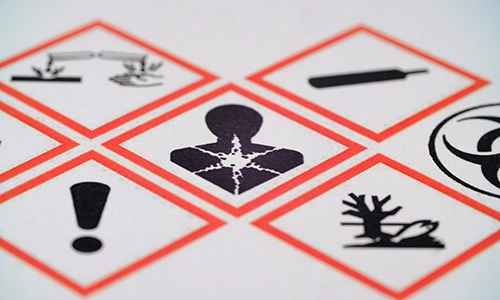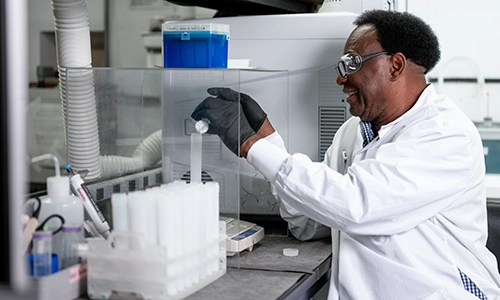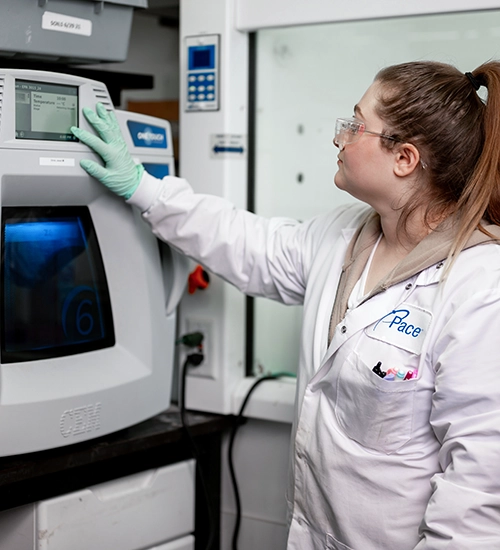Why Select Pace® For Low-Level Mecury Analysis
The largest American-owned environmental lab in North America, Pace® has a well-established reputation for delivering fast, reliable analytical services to a wide range of customers, including government agencies, industry, and environmental consultants. For over three decades, we have provided exceptional low-level mercury analysis services.
Our laboratory team adheres to EPA Method 1631, using ultra-clean sampling techniques (Method 1669) and conducting laboratory analysis under pristine, controlled conditions. This approach allows us to achieve the lowest possible detection limits and prevent common sample contamination issues. Our certifications include NELAC, DOD, and accreditation in every state that offers a lab accreditation program. Our team’s extensive knowledge, advanced analytical techniques, and state-of-the-art instrumentation guarantee that the data we produce is precise, dependable, and defensible.

What Is Mercury?
What Are The Health Effects Of Mercury Exposure?
Some health effects caused by exposure to mercury include irritation to the eyes, skin, and stomach; cough, chest pain, or difficulty breathing; insomnia, irritability, indecision, headache, weakness or exhaustion, and weight loss. Industrial workers are often the most at risk of adverse health effects due to mercury exposure. The level of exposure depends upon the dose, duration, and work being performed.


What Is Low-Level Mercury Analysis?
Low-level mercury analysis and testing in water and soil is becoming more common due to environmental contamination. To support NPDES permitting, Impaired Waters, and TMDLs (Total Maximum Daily Loads), the U.S. Environmental Protection Agency (EPA) and states are placing progressively lower permit limits on mercury in water. The low-level mercury test method provides the ability to assess compliance with mercury water quality standards (WQSs) below 0.2 ug/L.
What Test Methods Can Be Use For Low-Level Mercury Analysis
Analytical techniques for measuring mercury include cold vapor atomic absorption spectroscopy, cold vapor atomic fluorescence spectroscopy, and direct analysis by thermal decomposition. For low-level testing in water, mercury is analyzed using cold vapor atomic fluorescence spectrometry. Ultra-clean sampling techniques (Method 1669) and laboratory analysis under clean room conditions are used to ensure the lowest achievable detection limits and avoid common causes of sample contamination.
Cold vapor atomic fluorescence instrumentation is also used to analyze mercury content in sediment and tissue samples. Atomic fluorescence is an extremely sensitive measurement technique. Mercury in a digested sample is reduced with stannous chloride to elemental mercury and purged from the seawater matrix for analysis. The sensitivity of the analysis can be varied by adjusting the instrumental gain.

How Is Mercury Regulated?
Mercury regulation in the U.S. limits the maximum concentration of mercury permitted in air, water, soil, food, and drugs. The regulations are promulgated by agencies such as the EPA, the U.S. FDA (Food and Drug Administration), and a variety of state and local authorities. Specific regulations require that certain waters and soils be monitored for mercury at exceptionally low levels, sometimes referred to as ultra-trace levels.

The CWA sets federal standards for surface water and makes it unlawful to discharge pollutants into the Waters of the United States unless authorized by a permit from the EPA. Surface water, the receiving water for discharged wastewater, is monitored to ensure it does not contain contaminants higher than CWA standards. Federal law requires a review of water quality standards every three years. State laws may require more frequent reviews. The CWA also regulates how dredged or fill material may be deposited into lakes, wetlands, streams, rivers, and estuaries.
Created in 1972 by the CWA, the NPDES is designed to control and manage the discharge of pollutants, such as mercury, into Waters of the United States and protect water quality and aquatic life. States can petition the EPA to administer their own NPDES program, and most states have received partial or full approval. Without a permit, any discharge into a receiving body of water is considered unlawful.
As part of the CWA, the EPA adopted the National Toxics Rule, providing states with numeric criteria for toxic pollutants. It is used by the EPA and states to ensure Effluent Guidelines, water quality criteria, and NPDES permitting address pollutants in waterways. Mercury must be measured at a minimum level of 0.5 ppt (parts-per-trillion).
Under the TSCA, the EPA has broad authority to issue regulations designed to gather health/safety and exposure information on, require testing of, and control exposure to chemical substances and mixtures. The TSCA gives the EPA the authority to take specific measures to assess chemical substances and mixtures and protect against unreasonable risks to human health and the environment from existing chemicals.
The GLRI is a federal program that provides funding for on-the-ground restoration projects, from wetland restoration to cleaning up toxic hotspots. This initiative requires mercury to be measured at ultra-trace levels.
RCRA requires the EPA to oversee hazardous wastes, including mercury wastes, from generation, through storage and transportation, to final treatment and disposal. Before these wastes can be disposed of, they must meet the EPA’s treatment and recycling standards. RCRA also sets emission limits for combusted mercury-containing hazardous waste. States are largely responsible for implementing the RCRA program, and their requirements may be stricter than federal requirements.
The EPA regulates mercury at the federal level as a hazardous air pollutant and is thus subject to control under the National Emissions Standards for Hazardous Air Pollutants (NESHAPs) rather than the National Ambient Air Quality Standards (NAAQS).
EPCRA requires industrial and federal facilities to report chemical emissions, including mercury and mercury compound emissions. Reporting is done through the EPA's Toxics Release Inventory (TRI) Program.
The Food and Drug Administration (FDA) handles the regulation of mercury in food, drugs, and cosmetics. The FDA also regulates dental amalgam under FFDCA.
Test Methods For Low-level Mercury Analysis
EPA Method 1631
EPA Method 1631 is a performance-based analytical test method used to determine low-level mercury in water by oxidation, purge and trap, and cold vapor atomic fluorescence spectrometry. This method allows for the determination of mercury at ultra-trace levels in water matrices in support of the National Toxics Rule, the Final Water Quality Guidance for the Great Lakes System, NPDES permit limits, and Total Maximum Daily Loads (TMDL) measurements.
EPA Method 7474
In addition to its well-documented presence in seafood and water, mercury can also be found in soil, often as a by-product of manufacturing or mining operations. Pace® supports EPA Method 7474 for projects that call for a lower sensitivity level than the standard soil method.
Additional Resources
Need to find a lab that can handle your unique requirements?
Contact us directly or download our list of environmental certifications across our network.